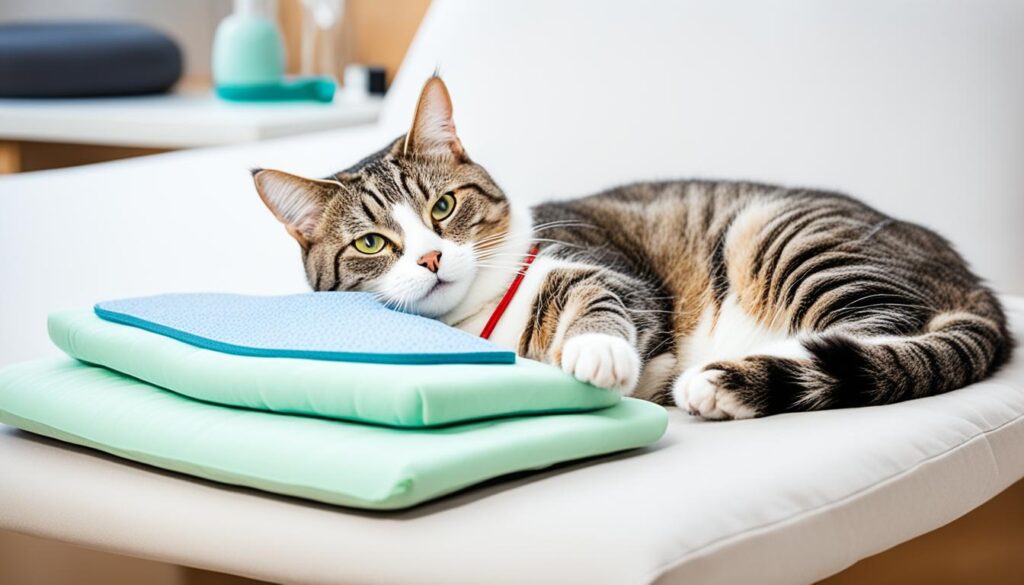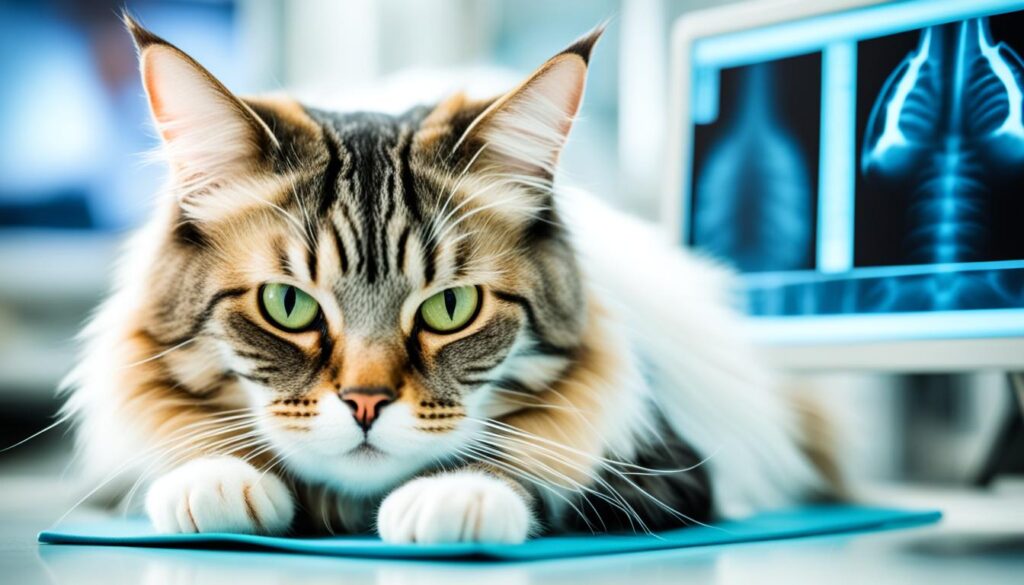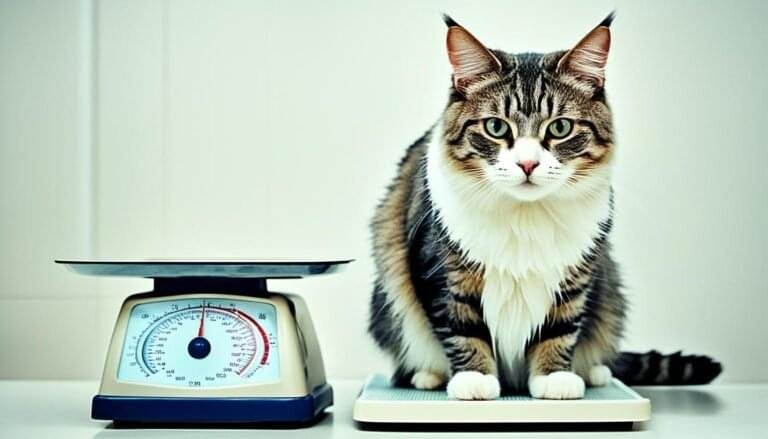Did you know that cat arthritis affects an estimated 60% of cats over the age of six?
Cat arthritis, also known as feline joint pain, is a common condition that can cause pain and discomfort in our feline companions. Just like humans, cats can experience inflammation and stiffness in their joints, making it difficult for them to move around comfortably.
In this article, I will provide you with valuable information on managing cat arthritis. From understanding the causes and clinical signs of arthritis in cats to diagnosing the condition and exploring various treatment options, I will guide you through the process of helping your furry friend live a more comfortable life.
Key Takeaways:
- Osteoarthritis (OA), or degenerative joint disease (DJD), is a common condition in cats that causes pain and inflammation in the joints.
- Factors such as body conformation, weight, abnormal joint development, injury history, orthopedic surgery, and nutritional history can contribute to the development of cat arthritis.
- Signs of arthritis in cats include difficulty getting up and down, stiff and swollen joints, loss of appetite, and behavior changes.
- Diagnosing cat arthritis involves physical examination, palpation of the joints, and additional diagnostic tests, such as X-rays.
- Treatment options for cat arthritis include nutrition, pain medication, nutraceuticals, physical therapy, and, in extreme cases, surgery.
Causes of Cat Arthritis
The development of cat arthritis can be influenced by various factors such as body conformation, weight, abnormal joint development, injury history, orthopedic surgery, and nutritional history. Contrary to popular belief, simply getting older is not a direct cause of arthritis in cats. These factors often work together to contribute to the initiation and progression of osteoarthritis in cats.
When it comes to cat arthritis causes, it’s important to understand that certain physical traits can predispose cats to joint problems. For example, cats with long bodies and short legs, such as Dachshunds or Munchkin cats, may be more prone to joint stress and arthritis. Similarly, excessive weight can put additional strain on a cat’s joints, leading to cartilage damage and inflammation.
Furthermore, conditions like hip dysplasia or luxating patella, which result from abnormal joint development, can increase the risk of arthritis in cats. These structural issues can disrupt the smooth movement of the joints, leading to wear and tear over time.
Injuries, such as fractures or ligament tears, can also contribute to the development of arthritis. Traumatic events can cause damage to the joints, leading to instability and subsequent arthritis. Similarly, cats that have undergone orthopedic surgeries, such as joint repair or reconstruction, may be more susceptible to developing arthritis in the affected joints.
Finally, a cat’s nutritional history plays a crucial role in joint health. Diets that lack essential nutrients like omega-3 fatty acids and antioxidants can contribute to inflammation and cartilage degeneration, increasing the risk of arthritis.
Overall, cat arthritis risk factors are multifaceted, with various elements interplaying to contribute to the development and progression of the condition. Understanding these causes can help cat owners take preventive measures and seek appropriate treatment to manage their cat’s arthritis.
Clinical Signs of Cat Arthritis
Cats can be masters at hiding pain, making it challenging for owners to detect early signs of arthritis. However, there are several common signs that may indicate the presence of this condition in cats. If you notice any of these signs, it’s important to consult with your veterinarian to determine if your cat has arthritis and develop an appropriate treatment plan.
Signs of Arthritis in Cats:
- Difficulty getting up and down: Arthritic cats may have trouble rising from a lying position or jumping onto furniture.
- Walking stiffly: Cats with arthritis often have a stiff gait and may appear to be “walking on eggshells.”
- Lameness: Arthritic cats may limp or favor certain legs when walking or running.
- Reluctance to climb stairs or jump: Cats with joint pain may avoid activities that require them to use their joints excessively.
- Decreased playfulness: Arthritis can dampen a cat’s enthusiasm for playtime.
- Swollen or sore joints: Inflamed joints can be tender to the touch and may appear swollen.
- Aggression: Some arthritic cats may become more defensive or aggressive when their painful joints are touched or manipulated.
- Increased hiding: Cats in pain may seek out secluded spots to rest and hide.
- House soiling: Arthritic cats may have difficulty accessing litter boxes, leading to accidents outside the box.
- Poor coat condition: Cats with arthritis may have a unkempt or less well-groomed appearance due to reduced mobility and discomfort.
Keep in mind that not all cats display the same signs of arthritis, and the severity of symptoms can also vary. If you suspect your cat may be experiencing joint pain or arthritis symptoms, it’s essential to seek veterinary care for an accurate diagnosis and appropriate treatment.
Diagnosing Cat Arthritis
When it comes to diagnosing cat arthritis, a thorough examination and diagnostic tests play a crucial role in accurately identifying the presence and extent of the condition. Working closely with your veterinarian is essential to determine an accurate diagnosis and develop an effective treatment plan.
During the diagnosis process, your veterinarian will conduct a comprehensive physical examination to assess your cat’s overall health, mobility, and joint function. This examination may involve palpating the joints, looking for signs of swelling, pain, or inflammation.
In addition to the physical examination, your veterinarian may recommend further diagnostic tests to confirm the presence of arthritis and evaluate its severity. These tests can include:
- X-rays: X-ray imaging allows your veterinarian to visualize the structure of your cat’s joints and assess any signs of degenerative changes associated with arthritis.
- Joint Aspiration: The removal of fluid from a joint (joint aspiration) can help your veterinarian determine if arthritis is present and assess the type of arthritis your cat may be experiencing.
- Blood Tests: Blood tests may be performed to rule out other underlying conditions that can cause similar symptoms to arthritis in cats.
These diagnostic tests, along with your cat’s clinical signs and medical history, provide valuable information that aids in the accurate diagnosis of cat arthritis. Once a diagnosis is confirmed, your veterinarian can create a tailored treatment plan to address your cat’s specific needs.
| Diagnostic Tests for Cat Arthritis | Pros | Cons |
|---|---|---|
| X-rays | – Allows visualization of joint structure and degenerative changes – Provides a definitive diagnosis |
– May require sedation or anesthesia for accurate imaging – Does not always reveal early stages of arthritis |
| Joint Aspiration | – Helps determine the presence and type of arthritis – Assists in relieving joint pain |
– Invasive procedure that can cause discomfort – Possibility of infection or bleeding |
| Blood Tests | – Rules out other conditions with similar symptoms | – Does not provide a definitive diagnosis for arthritis – Cannot assess the severity of arthritis |
Treating Cat Arthritis

While there is no cure for cat arthritis, there are various treatment options available to manage the condition. These include nutrition, pain medication, nutraceuticals, physical therapy, and surgery. The goal of treatment is to alleviate pain, improve mobility, and enhance the cat’s overall quality of life.
Nutrition
Nutrition plays a crucial role in managing cat arthritis. Specific diets are designed to normalize body condition and support joint health. These diets often contain ingredients such as glucosamine and omega-3 fatty acids, which have been shown to have a positive impact on joint health and inflammation reduction.
Pain Medication
Non-steroidal anti-inflammatory drugs (NSAIDs) or other pain medications may be prescribed by a veterinarian to help manage the pain and inflammation associated with cat arthritis. These medications can provide relief and improve the cat’s comfort levels.
Nutraceuticals
Nutraceuticals, such as joint-supporting supplements, can be beneficial in managing cat arthritis. Supplements containing glucosamine, chondroitin, and omega-3 fatty acids can help support joint health and reduce inflammation. It is important to consult with a veterinarian to ensure the appropriate dosage and type of nutraceutical for the cat.
Physical Therapy
Physical therapy can be a valuable treatment option for cats with arthritis. Acupuncture and physical rehabilitation techniques can help improve mobility, reduce pain, and increase joint flexibility. These therapies should be performed by trained professionals experienced in working with cats.
Surgery
In extreme cases where conservative treatment options fail to provide sufficient relief, surgery may be considered. Surgical interventions, such as joint replacement or joint fusion, can help alleviate pain and improve mobility in severely affected cats. However, surgery is usually reserved as a last resort when all other options have been exhausted.
By utilizing a combination of these treatment options under the guidance of a veterinarian, cat owners can effectively manage their cat’s arthritis and improve their overall well-being.
Natural Remedies for Cat Arthritis
As a cat owner, you may be looking for natural remedies to help manage your cat’s arthritis. While traditional medical treatment plays a significant role in managing the condition, natural remedies can be complementary and provide additional support. These natural remedies take a holistic approach to cat arthritis, addressing the overall well-being of your furry friend.
1. Natural Supplements
One popular natural remedy for cat arthritis is the addition of certain supplements to their diet. Glucosamine and omega-3 fatty acids have shown promise in providing joint support for cats with arthritis.
| Supplement | Description |
|---|---|
| Glucosamine | A natural compound that helps maintain healthy cartilage and joint function. It may reduce joint inflammation and improve mobility in cats with arthritis. |
| Omega-3 Fatty Acids | These essential fatty acids have anti-inflammatory properties and may help reduce joint pain and stiffness in cats with arthritis. |
2. Alternative Therapies
In addition to supplements, alternative therapies can also be beneficial in managing cat arthritis. These therapies take a holistic approach to the cat’s well-being and focus on restoring balance and promoting natural healing. Some popular alternative therapies include:
- Acupuncture: A technique that involves the insertion of thin needles into specific points on the cat’s body to stimulate circulation and promote pain relief.
- Cold Laser Therapy: The use of low-intensity lasers to reduce inflammation, relieve pain, and improve joint mobility.
These therapies should be administered by a qualified veterinarian who specializes in alternative medicine and has experience in treating cats with arthritis.
Creating a Cat Arthritis Diet
Nutrition plays a crucial role in managing cat arthritis. As a cat owner, it’s important to understand that a specific diet can be prescribed by your veterinarian to help normalize your cat’s body condition and support joint health. Following the recommended nutritional program strictly will ensure that your cat receives the appropriate nutrients and maintains a healthy weight, which is essential for managing arthritis.
Your veterinarian may recommend a cat arthritis diet that includes:
- Foods rich in omega-3 fatty acids: Omega-3 fatty acids have anti-inflammatory properties, which can help reduce joint inflammation and ease arthritis symptoms in cats. Fish oil supplements or cat food formulated with high levels of omega-3 fatty acids can be beneficial.
- Joint-supporting supplements: Certain supplements, such as glucosamine and chondroitin, can help promote joint health and improve mobility in arthritic cats. These supplements can be added to your cat’s diet in the form of treats or as part of their regular meals.
- Low-calorie options: Maintaining a healthy weight is crucial for cats with arthritis, as excess weight puts additional stress on the joints. Your veterinarian may recommend a low-calorie diet or specific portion control measures to help your cat achieve and maintain a healthy weight.
It’s important to note that every cat is unique, and their nutritional needs may vary. Consult with your veterinarian to determine the most suitable diet plan for your arthritic cat based on their specific condition.
By providing your cat with a well-balanced diet that supports their joint health, you are taking an active role in managing their arthritis and improving their overall quality of life.
Making Your Cat More Comfortable
If your cat is suffering from arthritis, there are simple steps you can take to improve their comfort and enhance their quality of life. By making a few adjustments to their environment and daily care, you can help alleviate their pain and improve their mobility.
1. Provide Soft, Padded Bedding
One way to make your arthritic cat more comfortable is by providing them with soft, padded bedding. Look for beds specifically designed for cats with arthritis, as they offer additional support and cushioning for achy joints. This will allow your cat to rest and sleep comfortably, helping to reduce pain and inflammation.
2. Raise Food and Water Dishes
Elevating your cat’s food and water dishes to a comfortable height can make mealtime less strenuous for them. This prevents them from having to bend down too far, reducing strain on their joints. You can use cat dish stands or even place the dishes on a stable surface like a low table or countertop to make eating and drinking easier for your cat.
3. Use Non-Skid Floor Surfaces
Cats with arthritis may struggle with traction on slippery floors, which can lead to slips and falls. To prevent accidents and provide better stability for your cat, use non-skid surfaces like rugs or specially designed mats. These surfaces will give your cat better grip when walking or moving around the house, helping to prevent further joint damage.
4. Provide Ramps or Steps
Mobility can be a challenge for cats with arthritis, especially when it comes to accessing higher surfaces like beds or sofas. Help your cat by providing ramps or steps that allow them to climb up and down comfortably. This will reduce the strain on their joints and make it easier for them to navigate their environment without experiencing pain.
5. Adhere to Feeding and Medication Recommendations
Following your veterinarian’s prescribed feeding and medication recommendations is crucial for managing your arthritic cat’s comfort. Consistency in feeding and administering medication (if required) is essential for providing relief from pain and inflammation. Make sure to follow the dosage instructions and schedule provided by your veterinarian to ensure the best possible care for your cat.
By implementing these measures, you can significantly improve your arthritic cat’s comfort and overall well-being. Remember to consult with your veterinarian for specific advice tailored to your cat’s individual needs.
| Steps to Make Your Cat More Comfortable |
|---|
| Provide soft, padded bedding |
| Raise food and water dishes to a comfortable height |
| Use non-skid floor surfaces |
| Provide ramps or steps for easy access to higher surfaces |
| Adhere to prescribed feeding and medication recommendations |
Prognosis for Cats with Arthritis

With appropriate management, cats with arthritis can live a normal life expectancy. The prognosis for cats with arthritis depends on various factors, including the severity of the condition, the effectiveness of treatment, and the overall health of the cat.
Factors Affecting Prognosis
When assessing the prognosis for a cat with arthritis, veterinarians consider several key factors:
- Severity of the condition: The extent and progression of arthritis in the cat’s joints play a significant role in determining the prognosis. Cats with mild arthritis may have better long-term outcomes compared to those with more severe joint damage.
- Effectiveness of treatment: Timely and appropriate treatment can help manage the symptoms of arthritis and slow down its progression. Cats that respond well to treatment and show improved joint function may have a more favorable prognosis.
- Overall health of the cat: The general health and well-being of the cat can influence the prognosis. Cats with underlying health issues or compromised immune systems may have a higher risk of complications and a less favorable prognosis.
It is important to note that every cat is unique, and the prognosis may vary for each individual. Your veterinarian will carefully assess the specific circumstances of your cat’s condition and provide you with a tailored prognosis based on their evaluation.
Improving Prognosis
To enhance the prognosis for a cat with arthritis, it is crucial to prioritize their overall care and well-being:
- Regular veterinary care: Consistent veterinary check-ups allow for ongoing monitoring and adjustment of the treatment plan as needed.
- Adherence to treatment plan: Following your veterinarian’s recommended treatment plan, including medication administration and any necessary lifestyle adjustments, is vital for maximizing the cat’s quality of life and managing the progression of the disease.
- Environmental modifications: Making modifications to the cat’s environment, such as providing easy access to litter boxes and elevated resting spots, can help alleviate strain on the joints and improve mobility.
- Weight management: Maintaining a healthy weight through proper nutrition and portion control can help reduce the strain on the cat’s joints and improve their overall prognosis.
| Factors | Influences on Prognosis |
|---|---|
| Severity of the condition | More severe arthritis may lead to a less favorable prognosis. |
| Effectiveness of treatment | Well-managed treatment can improve the cat’s prognosis and quality of life. |
| Overall health of the cat | Underlying health issues can impact the prognosis and require additional management. |
By providing comprehensive and diligent care for your cat with arthritis, you can help optimize their prognosis and ensure they enjoy a happy and comfortable life.
Preventing Cat Arthritis
While it may not be possible to completely prevent cat arthritis, there are certain measures that can help reduce the risk. By taking proactive steps, cat owners can promote the overall health and well-being of their feline companions. Here are some cat arthritis prevention tips:
- Allow your cat to grow slowly: Rapid growth in kittens can put extra stress on their joints, increasing the risk of arthritis later in life. Letting kittens grow at a steady pace can help prevent future joint problems.
- Maintain a lean body condition: Obesity is a major risk factor for arthritis in cats. Ensure your cat maintains a healthy weight through proper nutrition and portion control. Consult with your veterinarian to determine the appropriate diet for your cat.
- Provide regular exercise: Physical activity helps keep cats in good shape and promotes joint health. Engage your cat in play sessions and provide opportunities for them to climb, jump, and explore.
- Ensure proper nutrition: Feeding your cat a balanced and nutritious diet is essential for overall health, including joint health. Look for cat foods that contain ingredients known to support joint function, such as omega-3 fatty acids and glucosamine.
- Regular veterinary check-ups: Routine check-ups with your veterinarian allow for early detection and intervention. Your vet can assess your cat’s joint health, provide preventive care, and offer guidance on maintaining a healthy lifestyle.
By implementing these preventive measures, cat owners can significantly reduce the likelihood of their feline companions developing arthritis and enjoy many years of happy, healthy companionship.
Preventing Cat Arthritis Tips:
| Prevention Tip | Description |
|---|---|
| Allow slow growth | Rapid growth in kittens can increase the risk of arthritis in later life. Allowing kittens to grow at a steady pace can help prevent joint problems. |
| Maintain a lean body condition | Obesity is a major risk factor for cat arthritis. Ensure your cat maintains a healthy, lean body condition through proper nutrition and portion control. |
| Provide regular exercise | Physical activity helps keep cats in good shape and promotes joint health. Engage your cat in play sessions and provide opportunities for them to climb, jump, and explore. |
| Ensure proper nutrition | Feeding your cat a balanced and nutritious diet is essential for overall health, including joint health. Look for cat foods that contain ingredients known to support joint function, such as omega-3 fatty acids and glucosamine. |
| Regular veterinary check-ups | Regular check-ups with your veterinarian allow for early detection and intervention. Your vet can assess your cat’s joint health, provide preventive care, and offer guidance on maintaining a healthy lifestyle. |
Conclusion
Managing cat arthritis requires a holistic approach that combines medical treatment, natural remedies, dietary adjustments, and lifestyle modifications. While there is no cure for this common condition, early detection and intervention can significantly improve a cat’s quality of life and slow down the progression of the disease.
Working closely with a veterinarian is crucial in developing a personalized treatment plan for an arthritic cat. Together, you can explore a range of options such as pain medication, nutraceuticals, physical therapy, and even surgical interventions, depending on the severity of the arthritis.
In addition to medical treatments, natural remedies can also play a supportive role in managing cat arthritis. Glucosamine and omega-3 fatty acids supplements, as well as alternative therapies like acupuncture, can provide additional relief and support joint health.
Furthermore, maintaining a proper diet and ensuring your cat maintains a healthy weight are essential for managing arthritis symptoms. By following the veterinarian’s recommended nutritional program, you can help alleviate pain and support joint function.








[…] their discomfort and establish boundaries. By recognizing these warning signs, owners can better manage cat aggression and avoid potential […]